Introduction
In a commercial building, Heating, Ventilation, and Air Conditioning (HVAC) systems do far more than control temperature — they directly influence how comfortable, healthy, and productive a workplace is. Poor HVAC design can lead to stuffy rooms, fluctuating temperatures, or excessive noise, all of which impact employee satisfaction and efficiency. And just like electrical or fire safety systems, HVAC is part of the wider building services network that needs to work in harmony.
- Thermal Comfort Matters
When indoor temperatures are too hot or cold, it’s harder for people to focus. An effective HVAC design ensures:
- Zoned temperature control so different areas can be set to different needs
- Consistent airflow that avoids hot or cold spots
- Seasonal efficiency so comfort is maintained year-round
Studies have shown that thermal comfort directly affects cognitive performance and concentration levels. Similar to how good lighting design (electrical engineering) boosts productivity, thermal comfort has a measurable impact on workplace performance.
- Indoor Air Quality (IAQ) and Health
HVAC systems play a critical role in air quality. Poor ventilation can lead to:
- Increased spread of airborne illnesses
- Build-up of dust, allergens, and CO₂
- Fatigue and headaches among occupants
A well-designed system ensures adequate fresh air intake, effective filtration, and humidity control to maintain a healthy indoor environment. Importantly, this ties into fire engineering too — as smoke control and safe air circulation are crucial during emergencies.
- Ventilation Strategies for Productivity
Natural ventilation is great for fresh air, but it’s not always enough in a busy workplace. Mechanical ventilation systems can:
- Provide controlled airflow for optimal oxygen levels
- Remove stale air and indoor pollutants
- Reduce humidity to prevent mould growth
Combining natural and mechanical ventilation (a mixed-mode system) can boost both comfort and energy efficiency. This also integrates well with hydraulic services such as plumbing and drainage, since moisture and humidity management must align with overall building performance.
- Noise Control from HVAC Systems
An often-overlooked aspect of HVAC design is noise. Poorly installed or maintained systems can create:
- Constant humming or rattling
- Airflow noise through ducts
- Equipment vibration
A thoughtful design includes acoustic insulation and equipment placement to minimise disruption, keeping workspaces quieter and more focused. In modern mechanical engineering projects, noise control often works hand-in-hand with structural and electrical layouts to achieve a seamless design outcome.
- Energy Efficiency Without Sacrificing Comfort
Modern HVAC systems can deliver high comfort levels while keeping energy costs low. Key design features include:
- Variable speed drives for fans and compressors
- Smart thermostats that adjust based on occupancy
- High-performance insulation in ductwork
This means better working conditions without high utility bills. When combined with electrical automation systems, energy monitoring, and even fire safety compliance, HVAC becomes part of a smarter, safer, and more sustainable building strategy.
The Decobu Approach: HVAC Design That Works for People
At Decobu, we know that mechanical system design is about more than just meeting technical specifications — it’s about creating spaces where people can thrive. Our HVAC solutions focus on:
- Thermal comfort and air quality as core design principles
- Integration with energy-efficient controls and zoning
- Compliance with NCC and Australian Standards
- Tailored solutions for offices, retail, education, and healthcare facilities
And because we deliver MEPF engineering services under one roof (Mechanical, Electrical, Hydraulic, and Fire), our designs ensure every system complements the other for maximum comfort, safety, and efficiency.
FAQ: HVAC Design and Workplace Comfort
Q1: What’s the ideal office temperature in Australia?
Generally, 22–24°C in summer and 20–22°C in winter is recommended for comfort and efficiency.
Q2: How often should HVAC filters be changed?
Every 3–6 months for most commercial systems, depending on usage and environment.
Q3: Can HVAC systems help reduce sick days?
Yes. Improved ventilation and air filtration can lower the spread of airborne illnesses — much like fire systems reduce emergency risks by improving safety outcomes.
Q4: Is a smart HVAC system worth it?
Absolutely — smart controls optimise comfort and energy use automatically, especially when linked with electrical building management systems.
Q5: How does HVAC impact productivity?
Better air quality, stable temperatures, and low noise levels all improve focus and well-being. And when HVAC works in synergy with lighting, hydraulics, and fire safety systems, it creates a building that supports productivity on every level.
Final Word
Workplace comfort isn’t just about aesthetics — it’s built into the mechanical systems that power your building. A well-designed HVAC system improves health, reduces distractions, and supports higher productivity while keeping energy costs under control. At Decobu, we take a holistic approach — making sure HVAC, electrical, hydraulic, and fire engineering services work together to create smarter, safer, and more efficient workplaces.





